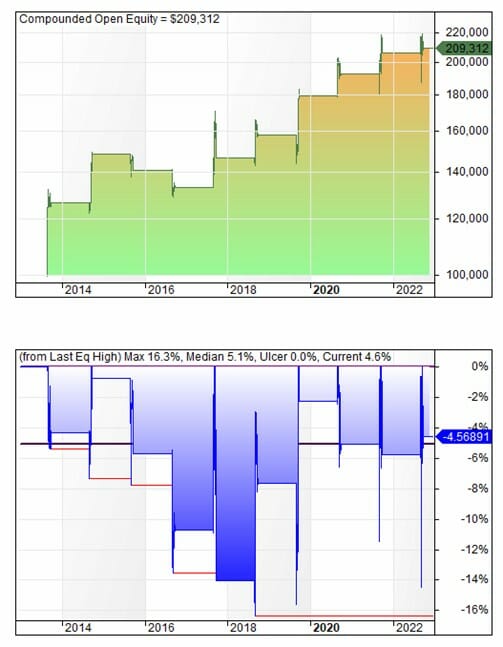The capital market is known for its dynamics and volatility. There are various factors that can influence the performance of the stock market and even more the crypto market. One of these factors is seasonality.
Seasonality is a term that encompasses reoccurring time-related price behavior effects. These effects can pertain to individual calendar months or specific holidays. The crucial aspect of seasonality is its recurring nature. If a price behavior has a repeating character, it can be systematically exploited. A character which we like as systematic traders.
“Sell in May and go away, but remember to come back after September”
Historically, we can observe that certain calendar months are on average more profitable than others. This effect is called the calendar month effect. It is worth noticing that we are talking from monthly averages which are based on historical results. Average figures can be biased by big outliers and usually change over time.
A common mistake when looking to trade seasonal tendencies is to take the historical results for granted and trade them with no other confirmation rules in place. This is called Hind Sight bias. As a systematic trade we want to avoid this.
Just blindly following past seasonal averages may lead to unpleasant surprises. However, we can say with certainty, that there are certain persisting dynamics in the distribution of monthly returns which may give us an edge. Looking at the NASDAQ100 historical monthly performance, we can observe a clear pattern of weakness in September for example.

Figure 1: Monthly average return performance for Nasdaq100
The months October and November are historically strong performers, whereas September is by far the weakest trading month of all months. Interestingly, this effect is widely spread through global stock market indices.
As we already mentioned. If a certain price behavior persists, we can exploit it profitably. Long or short, as long as there is consistency in combination with a statistical edge, we can trade it. This is exactly what we are looking for as systematic traders.
As of the time of writing, September is just around the corner. A trading month with historical weak performance. In other words, an ideal month to go short!
Ideally, we need to find a suitable market with strong price movements in order to squeeze the most of this anomaly. There is no market with stronger price movements than the cryptocurrency market! What if the calendar month also shows up in the monthly historical data of Bitcoin?

Figure 2: Monthly returns for Bitcoin from 2013 – 2023.
The table above shows us good news – The weak seasonal profile of September month effect is very clear in the Bitcoin price history. But before we get too excited, let’s take a step back and have a closer look at the data.
In order to trade a seasonal strategy, we need persistency and profitability in the pattern. Thus, we want to be sure this seasonal pattern gives us two things:
- A low variation of return realizations
- A high probability of a profitable outcome
Looking at the monthly return profile, the average return for Bitcoin in September is -7.5% with a median return of -5.8%. If we calculate the standard deviation of returns for each month, we see that September exhibits the lowest variation in its returns. This improves our confidence that this seasonal anomaly is tradeable and it is less likely that it was caused by just a couple of outliers.

Figure 3: Standard deviations of returns in Bitcoin by month of the year
Instead of focusing on the average, we will receive more robust insights, if we pay attention to the median because the median is not impacted by outliers as much as the average. We can see from Figure 2 above that both the median and the average return from Bitcoin in September has been negative in the past.
The probability of success based on the (relatively brief) history of Bitcoin is also in our favour because 8 out of the last 10 years have experienced declines in the price of Bitcoin. So overall, the statistics are promising.
Finally, we compare the returns statistics for all trading months based on a ‘short at the start of the month and cover at the end of the month’ strategy. Although January or June might be suitable for shorting in a diversified portfolio, there max drawdowns are unbearable. In summary, the data indicates applying the calendar effect for shorting the Bitcoin in September, is a reasonable approach.

Figure 4: Compound annual return and maximum historical drawdown from shorting each calendar month.
After we come to the conclusion that shorting the BTC has an edge, let’s backtest this simple strategy.
Bitcoin September Weakness Trading Strategy
The most important thing to realize with a monthly seasonality trading strategy is that there are very few data points (only one September each year!), and this challenge is even more notable with Bitcoin which was only invented recently… we have 10 years of history which is not a lot to work with, so the strategy needs to be elegant, simple and robust!
The strategy needs to be elegant, simple and robust. Otherwise, we risk curve fit and an instable trading strategy.
Seasonality Trading Strategy 1: Short Bitcoin for all of September
Let’s start our backtesting with the strategy in its simplest form. We short on the closing of the first day of the month and cover the position on the last trading day of the month. That’s it. We could not make it any simpler! With this strategy we receive a fairly strong performance metrics:
- Annual Return: 7.66%
- Exposure: 7.71%
- Risk Adjusted Return: 99.41%
- Max Drawdown: 16.34%
- CAR/MDD: 0.47
- Average Profit Per Trade: 8.33%

Figure 5: Backtested equity curve (top) and drawdown profile (bottom) for September Seasonality Trading Strategy 1
As a systematic traders, we love simple strategies – they give confidence and tend to perform better than complex strategies in real time trading because they are more robust and cope better with future unseen data.
So trading strategy 1 has clearly been profitable, though the equity curve is a little unstable.
Now let’s look at some variations to see if we can improve on this simple strategy with some simple
Seasonality Trading Strategy 2: Short Bitcoin on Weakness in September
A general rule of thumb for short selling systems is to require weakness in the underlying symbol before entering a position – in other words, waiting for confirmation that the price is falling.
Instead of just shorting on the 1st of September we wait for a down day, seasonality trading strategy 2 waits until today’s close is lower than yesterday’s close in September, then it goes short Bitcoin. The exit rule stays the same. We still wait until the last trading day of the month to cover our position. This strategy has no stops or other exits.
Here are the backtest results for strategy 2:
- Annual Return: 7.86%
- Exposure: 7.44%
- Risk Adjusted Return: 105.56%
- Max Drawdown: 16.12%
- CAR/MDD: 0.49
- Average Profit Per Trade: 8.54%
Although the added entry filter on weakness does provide some extra value in the form of a slightly higher annual return and a slightly lower drawdown, the impact is limited. However, it is reasonable to keep the addition, as the nature of it goes in line with the characteristics of a short trade.
Seasonality Trading Strategy 3: Short Bitcoin on Weakness in September (Enhanced)
Shorting strategies can be a powerful addition to a portfolio, but they also carry some risk. For us, trading a short system without a proper risk management, is like free climbing without a rope. Going all in blind without a stop loss is not a reasonable strategy – so in strategy 3 below we have addressed this issue.
In our final strategy we incorporate a robust risk management which suits Bitcoin’s price behavior along with an additional exit to smooth the returns. In addition to that, we have also added an additional, elegant rule which ensures we maximise the benefit from the monthly calendar effect. These exact rules have not been disclosed here, but you can download the strategy rules and code for FREE here.
Here are the final results for our Seasonal Trading Strategy 3 which shorts Bitcoin:
- Annual Return: 10.26%
- Exposure: 7.10%
- Risk Adjusted Return: 144.61%
- Max Drawdown: 15.32%
- CAR/MDD: 0.64
- Average Profit Per Trade: 11.22%
As you can, the annual return is now above 10%, we have further reduced the drawdown, substantially improved the average profit per trade and smoothed the backtested equity curve.

Figure 6: Backtested equity curve for our final seasonality strategy based on the September effect.

Figure 7: Backtested drawdown profile for our final seasonality strategy based on the September effect.
Conclusion on the September Seasonality Effect in Bitcoin
In conclusion, we have demonstrated that the statistical quality of the September effect is attractive for systematic trading. Although the number of observations is limited, we were able to demonstrate the robustness of this seasonal pattern. With a CAR/MDD of 0.64 and a risk adjusted return of 144%, our September Bitcoin Short Strategy offers very attractive risk-return metrics for a short system.
With two elegantly simple enhancements to the basic strategy, we are pleased to offer this seasonal short system for the BTC as a free download by clicking here.
The good news is that this strategy can be easily traded by anyone as its rules are simple, logical and easy to follow. You just need a broker which provides the option to short the BTC. Luckily, there are a few options, ranging from Binance, Kucoin to the 21 shares Short Bitcoin ETF.
This trading strategy has some unique features worth highlighting:
- Time: Once the trade is placed and the risk management set, there is nothing more to do. It takes just 5 minutes, once a year!
- Software: Don’t want to learn or use trading software? No problem – You can seamlessly implement the Bitcoin September Short Strategy without software. All you need is a crypto broker that enables shorting Bitcoin or the ability to short a Bitcoin ETF on the stock market.
- Coding: The trading rules are elegantly simple and don’t need coding. The logic is 100% objective and can easily be seen using only the chart. Of course I also give you the code for Amibroker so you can backtest the strategy for yourself if you desire.
- Complexity: The Bitcoin September Short Strategy is driven by simplicity – simple is key for seasonality based trading strategies.
- Over Optimization: Over-optimization can be a silent profit killer. The Bitcoin September Short is based on logic and not parameter optimization.
- Experience: No prior algo or systematic trading experience is required
- Capital: Since this is a single instrument system, you can trade it even if you only have a small account. Bitcoin can be bought or sold in very small increments making this strategy accessible to traders of any size.









Share This
Share this post with your friends!